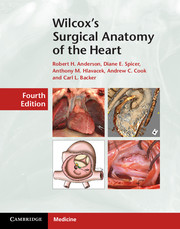Book contents
- Frontmatter
- Contents
- Preface
- Acknowledgements
- Surgical approaches to the heart
- Anatomy of the cardiac chambers
- Surgical anatomy of the valves of the heart
- Surgical anatomy of the coronary circulation
- Surgical anatomy of the conduction system
- Analytical description of congenitally malformed hearts
- Lesions with normal segmental connections
- Lesions in hearts with abnormal segmental connections
- Abnormalities of the great vessels
- Positional anomalies of the heart
- Index
- References
Lesions in hearts with abnormal segmental connections
Published online by Cambridge University Press: 05 September 2013
- Frontmatter
- Contents
- Preface
- Acknowledgements
- Surgical approaches to the heart
- Anatomy of the cardiac chambers
- Surgical anatomy of the valves of the heart
- Surgical anatomy of the coronary circulation
- Surgical anatomy of the conduction system
- Analytical description of congenitally malformed hearts
- Lesions with normal segmental connections
- Lesions in hearts with abnormal segmental connections
- Abnormalities of the great vessels
- Positional anomalies of the heart
- Index
- References
Summary
In the previous chapter, we paid attention to those hearts in which the associated cardiac malformation existed in the setting of normal connections between the cardiac segments. All those associated lesions, of course, can also be found in hearts with abnormal segmental connections. It is these abnormal connections that will be our focus in this chapter, emphasising the associated anomalies that are particularly frequent with a given abnormal segmental arrangement. We conclude the chapter with a brief discussion of those hearts in which the relationships of the arterial trunks are abnormal in the setting of concordant ventriculoarterial connections, as these combinations still produce problems in understanding and description.
DOUBLE-INLET VENTRICLE
Over the years, hearts with a double-inlet ventricle have represented one of the greater challenges to surgical correction. They have also posed significant problems in adequate description and categorisation. Even these days, many continue to describe the lesions in terms of single ventricles, or univentricular hearts, despite the fact that almost all patients with a double-inlet atrioventricular connection have two chambers within their ventricular mass, one being large and the other small–. The semantic problems with description can now be resolved by the simple expedient of describing functionally univentricular hearts, this approach also accounting for the other lesions dominated by ventricular imbalance. At this point, we describe the relevant anatomical characteristics of all those hearts unified by the presence of the double-inlet atrioventricular connection, irrespective of whether they contain one or two ventricles, although almost all do have one big and one small ventricle. The previous problems with description centred on whether the small chamber in hearts with ventricular imbalance deserved ventricular status.
- Type
- Chapter
- Information
- Wilcox's Surgical Anatomy of the Heart , pp. 244 - 320Publisher: Cambridge University PressPrint publication year: 2013

